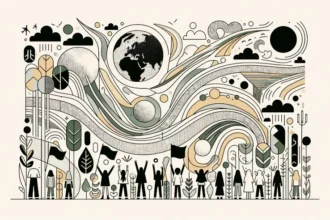Modern slavery, encompassing human trafficking, forced labor, and related exploitative practices, continues to be a disturbing reality today. Despite being legally banned in many nations, it endures in covert manifestations, deeply interwoven with the global economy. This phenomenon, often hidden yet pervasive, raises critical concerns about our economic and ethical systems.
The present article aims to unravel the intricate layers of modern slavery, focusing on its economic aspects and the widespread challenge it represents. By examining the economic roots and consequences of these practices, the article seeks to shed light on this global issue, urging a reevaluation of our economic interactions and their unintended support for such inhuman practices.
The Nature of Modern Slavery
Modern slavery, a complex and global concern, thrives on exploiting a vulnerable segment of the population. It manifests in diverse forms such as child labor, forced labor, sex trafficking, and labor trafficking, affecting millions worldwide. These practices are not isolated incidents but rather systemic issues deeply embedded in the fabric of global economic activities.
Modern slavery becomes intertwined with legitimate global trade and supply chains.
At its core, modern slavery is about the dehumanization and commodification of people for profit. Victims are often tricked, coerced, or forced into labor or sexual exploitation, with little to no chance of escape. These individuals, stripped of their rights and freedoms, are treated as mere commodities in a lucrative market that thrives in the shadows of the global economy.
The economic drivers behind modern slavery are multifaceted. On one hand, the relentless pursuit of cheaper labor and production costs by businesses contributes to the perpetuation of these practices. In their quest for maximized profits, some corporations may turn a blind eye to exploitative labor conditions in their supply chains. On the other hand, poverty and lack of economic opportunities make certain populations particularly susceptible to being trafficked and exploited.
This form of slavery is not restricted to developing countries; it is a global issue that transcends borders. From the fields and factories in remote areas to urban centers in developed nations, modern slavery is more widespread than often realized. It exists in industries ranging from agriculture and manufacturing to hospitality and domestic work, often hidden in plain sight.
The integration of modern slavery into everyday life is alarming. Products and services used daily may have links to slave labor, implicating consumers in this unethical cycle. This reality challenges individuals and businesses alike to become more conscious of their economic choices and the potential impact on human rights.
Modern slavery is an intricate and pervasive issue, closely linked to global economic systems. It requires a concerted effort from governments, businesses, civil society, and individuals to recognize, address, and ultimately eradicate this blight on humanity.
The Economic Underpinnings of Slavery
Understanding the economic foundations of modern slavery is essential to comprehending its persistence and expansion. The phenomenon’s profitability stems primarily from reduced transportation costs and the perceived disposability of human lives, factors that have facilitated its infiltration into numerous sectors of the global economy. This insidious integration has not only escalated the exploitation of vulnerable individuals but also made human trafficking an increasingly profitable venture for those orchestrating it.
Products and services that we consume daily could have hidden connections to slave labor.
The economic appeal of slavery to traffickers lies in the minimal investment required to exploit individuals and the high profits generated from their labor or exploitation. This grim reality is further exacerbated by the global demand for cheap labor and products, which often leads corporations to seek cost-effective solutions, sometimes at the expense of human dignity and rights. The result is a disturbing scenario where modern slavery becomes intertwined with legitimate global trade and supply chains.
Furthermore, the economic underpinnings of slavery extend to its impact on national and global economies. Economies that rely heavily on forced labor or tolerate such practices may experience short-term gains but face long-term consequences, including social and economic instability. The presence of slavery within an economy also contributes to a distortion of labor markets, undermining fair labor practices and the rights of workers.
An important aspect of this issue is the indirect support that consumers and businesses may provide to slavery through their economic choices. Products and services that we consume daily could have hidden connections to slave labor, raising ethical and moral questions about our complicity in these practices. Therefore, understanding the economic dynamics of modern slavery is not just an academic pursuit but a necessary step towards responsible consumerism and corporate accountability.
This relationship between modern slavery and global economic systems highlights the need for a comprehensive understanding of how economic practices, both at the individual and corporate levels, can contribute to or combat this grave human rights violation. It calls for a closer examination of supply chains, corporate responsibility, and consumer awareness to ensure that economic activities do not inadvertently perpetuate modern slavery.
Legal Frameworks and Measurements
The legal landscape addressing human trafficking has evolved significantly over the years, marked by pivotal legislation such as the UK’s Modern Slavery Act of 2015. These laws represent a crucial step forward in acknowledging and tackling the issue of modern slavery. However, they are not without shortcomings, and their effectiveness often varies, underscoring the need for ongoing evaluation and refinement.
Developing innovative methodologies to measure human trafficking is thus essential.
One key challenge with existing legal frameworks is their limited scope in addressing the complex nature of human trafficking. Many laws focus primarily on penalizing traffickers, but they may lack comprehensive measures for victim protection, rehabilitation, and reintegration. Additionally, the international variation in legal standards and enforcement practices can create loopholes that traffickers exploit, further complicating efforts to combat this crime globally.
Another significant issue is the difficulty in accurately measuring the extent of human trafficking. The hidden and illicit nature of these activities makes it challenging to obtain reliable data. Current methodologies often rely on estimates and indirect indicators, which may not fully capture the scale or nuanced dynamics of trafficking networks. Accurate measurement is crucial, as it informs the development and implementation of effective prevention and intervention strategies.
Developing innovative methodologies to measure human trafficking is thus essential. This could include leveraging technology for data collection and analysis, as well as fostering international collaboration for information sharing and standardization of measurement techniques. Enhanced data gathering not only aids in understanding the prevalence of trafficking but also in identifying patterns, hotspots, and victim profiles, thereby enabling targeted and effective responses.
Furthermore, legal frameworks need to be adaptable and responsive to the evolving tactics of traffickers. Continuous assessment and amendment of laws, informed by accurate data and research, are vital to ensure that legal responses remain effective and relevant in addressing the multifaceted and dynamic nature of human trafficking.
While legal advancements in addressing human trafficking are noteworthy, there is a pressing need for continuous improvement of these frameworks and for developing more sophisticated methods of measuring trafficking activities. These efforts are essential in building robust, effective strategies to combat modern slavery and protect its victims.
Technology’s Role in Trafficking
Technology plays a dual role in the realm of human trafficking, acting both as a facilitator for traffickers and as a powerful tool for combating this crime. The digital age has introduced new avenues for traffickers to operate, leveraging online platforms and advanced communication methods to expand their networks and evade detection. This digital evolution has transformed the landscape of human trafficking, making it more complex and challenging to address.
Technology’s role in human trafficking is multifaceted, presenting both challenges and opportunities.
The facilitative aspect of technology in trafficking is evident in how traffickers use the internet and social media to recruit, exploit, and control their victims. Online platforms offer anonymity and a broad reach, enabling traffickers to connect with potential victims from various geographies. The ease of disseminating misleading information and false promises online has made it simpler for traffickers to lure individuals into exploitative situations. Additionally, the dark web provides a hidden marketplace for illicit activities, including the sale of trafficked individuals, making it a particularly challenging domain for law enforcement agencies.
Conversely, technology also presents opportunities to combat human trafficking. Innovations in data collection and analysis, for instance, allow for more effective tracking of trafficking patterns and networks. Law enforcement agencies can utilize advanced algorithms and machine learning techniques to identify potential trafficking activities and intercept them. Additionally, technology can aid in victim identification and support, offering discreet and secure platforms for reporting and accessing help.
There is also an increasing emphasis on using technology for awareness and education. Online campaigns and digital platforms can effectively disseminate information about the dangers of human trafficking, reaching a wide audience and fostering a more informed and vigilant society. Furthermore, collaborations between tech companies, NGOs, and governments can lead to the development of specialized tools and applications geared towards prevention, detection, and response to trafficking scenarios.
Technology’s role in human trafficking is multifaceted, presenting both challenges and opportunities. While it has expanded the capabilities of traffickers, it also offers innovative ways to fight against this crime. Leveraging technology effectively is crucial in the ongoing battle against human trafficking, necessitating a balanced approach that maximizes its benefits while mitigating its risks.
Child Labor Trafficking in the US
Child labor trafficking in the United States represents a critical yet often overlooked facet of modern slavery. Contrary to the common perception that human trafficking is predominantly a problem in developing countries, this issue is also prevalent in the U.S., revealing a significant domestic dimension. The trafficking of children for labor in the United States encompasses various forms, including agricultural work, domestic servitude, and exploitation in industries such as hospitality and entertainment.
This form of trafficking typically involves the coercion, deception, or forceful employment of children in laborious activities. These young victims are often subjected to harsh working conditions, long hours, and minimal or no compensation. The subtlety with which child labor trafficking operates in the U.S. contributes to its hidden nature, making it a challenging issue to identify and address.
One of the primary reasons child labor trafficking persists in the U.S. is the presence of vulnerable populations who are more susceptible to exploitation. These include children from low-income families, migrant communities, and those with unstable home environments. Traffickers often exploit the vulnerabilities of these groups, preying on their need for income or the absence of adequate adult supervision and protection.
Addressing child labor trafficking in the U.S. requires a multifaceted approach. Focused research is crucial to understand the extent, nature, and mechanisms of this issue. Such research can inform the development of targeted interventions, policies, and programs. There is also a need for increased awareness and education among the public, as well as training for professionals who are in a position to identify and respond to cases of child labor trafficking, such as educators, social workers, and law enforcement officers.
Moreover, strengthening legal frameworks and law enforcement strategies is essential to prevent child labor trafficking, protect victims, and prosecute perpetrators. This includes enhancing collaboration between federal, state, and local agencies, as well as partnering with non-governmental organizations and community groups.
Child labor trafficking in the U.S. is a significant problem that requires attention and action. It calls for dedicated research, tailored interventions, and a concerted effort from various stakeholders to effectively combat this hidden crime and protect the vulnerable children affected by it.
Entrepreneurship in Combating Trafficking
Entrepreneurship and innovation are emerging as vital tools in the fight against human trafficking. By harnessing the power of new business models and creative solutions, entrepreneurs are making significant strides in combating this complex global issue. This proactive approach requires not only a deep understanding of economic principles but also a steadfast commitment to human rights and social justice.
The role of entrepreneurs in this context is multifaceted. First, they can innovate in creating technologies and platforms that aid in the detection and reporting of trafficking activities. For example, the development of apps and online tools that allow for the anonymous reporting of suspected trafficking or support services for victims can play a crucial role in prevention and intervention.
Second, entrepreneurs can contribute to disrupting the economic incentives of trafficking. This involves developing sustainable business models that offer viable alternatives to exploitative practices. For instance, social enterprises that provide fair employment opportunities to vulnerable populations can reduce the risk of exploitation and trafficking. Such initiatives not only offer economic benefits but also empower communities and foster resilience against trafficking.
Moreover, entrepreneurs can collaborate with various stakeholders, including governments, NGOs, and corporations, to develop comprehensive strategies to combat human trafficking. This collaboration can take many forms, from raising awareness and shaping public policy to driving corporate responsibility and ethical supply chain practices.
A key element of entrepreneurship in this arena is creativity and out-of-the-box thinking. Innovative approaches, such as leveraging blockchain technology for transparent supply chain management or utilizing artificial intelligence for data analysis and pattern recognition in trafficking networks, demonstrate the potential of entrepreneurship to make a significant impact.
Furthermore, entrepreneurship in combating human trafficking also involves a strong educational component. Entrepreneurs can engage in awareness campaigns and educational programs that inform the public about the realities of trafficking and how to prevent it. By fostering a more informed society, the risk of trafficking can be significantly reduced.
By developing new business models, technological solutions, and collaborative strategies, entrepreneurs are at the forefront of tackling this global issue. Their unique blend of creativity, economic acumen, and dedication to human rights is not only transforming the landscape of anti-trafficking efforts but also paving the way for a future where human trafficking is a relic of the past.
Conclusion
The continued existence of modern slavery, encompassing human trafficking and forced labor, represents a profound violation of human dignity and a major obstacle to socio-economic progress worldwide. Addressing this issue demands a comprehensive and multi-pronged strategy that integrates legal, technological, economic, and entrepreneurial approaches. A crucial aspect of this challenge is understanding how modern slavery operates within and impacts the global economy. Developing effective strategies to eliminate these practices requires insights into their economic mechanisms and consequences.
However, the responsibility to combat modern slavery extends beyond the realms of academia and policy-making. It is a collective obligation that calls for engagement and action from every segment of society. This includes raising awareness among the general public, promoting ethical practices within businesses, and fostering a global culture that actively opposes all forms of human exploitation.
Eradicating modern slavery is not just a moral imperative but also a necessary step towards building a more equitable and just world. It requires unwavering commitment and coordinated efforts from individuals, communities, governments, and international organizations. By working together, we can hope to dismantle the structures that enable modern slavery and create a future where freedom and dignity are universal rights, unmarred by the shadow of slavery.
Adapted from an academic article for a wider audience, under license CC BY 4.0














